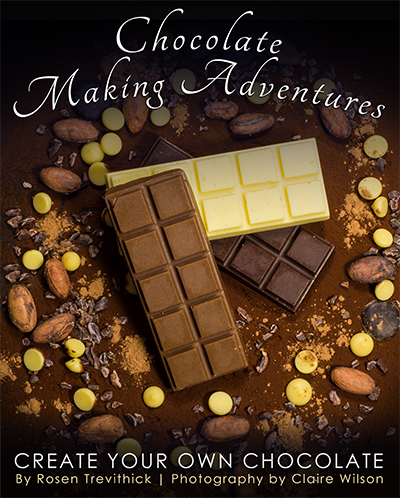How to Make Vegan 'Milk' Chocolate
✔ vegan ! contains nuts
My upcoming recipe book Chocolate Making Adventures will include chocolate recipes for people with a variety of dietary requirements. All of my recipes are vegetarian, but I've also included alternative versions of milk, white and plain, for those who wish to avoid honey and dairy.
This milk chocolate substitute uses a blend of cashew and coconut butters for a creamy taste, and agave nectar for sweetness. It is exceptionally delicious.
makes roughly 100g
(e.g. one 60 x 86 x 20mm bar)
You will need chocolate moulds, yoghurt pots or plastic cups.
INGREDIENTS
45g cocoa butter
2 tsp cashew butter
2 tbsp agave nectar
2 tsp coconut butter
4 tsp cocoa powder
METHOD
1. Start with a cool, dry kitchen.
2. Place the cocoa butter in a heatproof bowl above a pan of boiling water. Stir from time to time, until melted. This may take longer than you expect.
3. Stir in the cashew butter, coconut butter, cocoa powder and agave nectar. The coconut butter will take a few moments to dissolve, but has a low melting point, so should blend in quite quickly. The mixture is likely to look a horrible mess and you may wonder if it will ever combine - trust me, it will during the next steps.
4. Being careful to wipe condensation off the bottom of your melting pot, pour the mixture onto a cool granite or marble slab, using a scraper and palette knife to ensure that it doesn't run off the edges.
5. Cool the mixture by working it back and forth with the scraper. Repeatedly spread it out to increase the surface area then scrape it back together. If the mixture doesn't start to thicken after five minutes, try opening a window to cool down your kitchen.
6. Once the mixture has combined smoothly and reached the texture of margarine, scrape it back into the bowl and return to the pan. You should not need to return the water to the boil as a gentle heat will suffice.
7. Stir until the chocolate is just thin enough to pour. Allowing the chocolate to become too thin could cause the ingredients to separate in the mould.
8. Pour into moulds and refrigerate immediately, or use as directed in your recipe.
9. After one hour, pop the chocolate out of your moulds.
10. Chocolate containing coconut butter needs to be kept in the fridge. Store for up to one week.
+














Hi Rosen! I tried this recipe today and I just couldn't get it to thicken! I did use coconut oil instead of coconut butter and I think that might be where the issue lies... Any tips grafefully received!